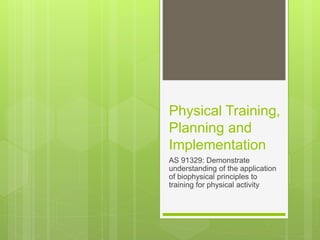
12SPS Physical training, planning and implementation
- 1. Physical Training, Planning and Implementation AS 91329: Demonstrate understanding of the application of biophysical principles to training for physical activity
- 2. 1. Strength 2. Speed 3. Power 4. Balance 5. Flexibility 6. Reaction Time 7. Agility 8. Endurance – CV 9. Endurance – Muscular 10. Co-ordination 11. Body Composition Components of Fitness
- 3. Strength The force that muscles or a group of muscles can exert in one maximal exertion/effort or contraction
- 4. Speed The ability to move the body quickly or at speed, over a given distance e.g.
- 5. Power The ability to generate maximum force quickly.
- 6. Balance The ability to maintain a position in space
- 7. Flexibility The flexibility or Range of motion around a joint
- 8. Reaction Time The time it takes to process and initiate action
- 9. Agility The ability to change direction suddenly when moving at speed.
- 10. Endurance - CV Ability of the Heart, lungs and blood vessels to take up and deliver oxygen to the working muscles for long periods of time.
- 11. Endurance - Muscular The ability of a muscle or group of muscles to contract repeatedly over a long period of time
- 12. Co-ordination The ability to use different parts of the body together smoothly and efficiently
- 13. Body Composition The percentages of fat, bone, muscle and water in the human body.
- 15. Frequency How often you should train: Training Frequency is dependent on the type of training Endurance (aerobic) – 4-6 days / week Non-endurance (lactic acid) – 3-4 days /week Non-endurance (ATP-PC) 2-3 days/week
- 16. What happens if Frequency of training is too high? Injury Burnout Fatigue – leading to poor technique/performance Boredom
- 17. Intensity How hard you should train: What is the correct intensity? In order to make improvements you need to train at the intensity that replicates your sport/performance
- 18. Intensity – Energy Systems Aerobic – 50-75% of Max Heart Rate Lactic Acid – 75-90% of Max Heart Rate ATP-PC – 90-100% of Max Heart Rate
- 19. What happens if you train too hard or not hard enough? Too Hard: Injury Poor performance Burnout Too Little: Make no improvement Poor improvement Lack of motivation from poor improvement
- 20. Duration (Time) Length of time you train or apply stimuli Over the course of a training session you should apply intensity, If you do not apply intensity during sessions gains are minimised.
- 21. Duration – Session Length Aerobic – 30-60mins, intensity ranging between 50-75% of Max HR Lactic Acid – 30-45min, intensity ranging between 75-90% of Max HR ATP-PC – 20-30min, intensity ranging between 90-100% of Max HR
- 22. Duration of activities within each training session Aerobic activities – any cardiovascular activity, like running, that is continuous. Working at 50-75% of Max HR. Activities can go beyond 2 hours depending on the sport/activity athlete is training for. Lactic Acid – intermittent exercises that last up to 2mins of work at intensity ranging between 75- 90% of Max HR. ATP-PC – short, high intensity bursts of energy performing activities that last no-longer than 15sec at 90-100% of Max HR.
- 23. Implications for athletes regarding duration and intensity Because as you gain, make improvements, you need to apply intensity for longer to maintain or continue to improve what has been gained. This means increased devotion of time to training.
- 24. Continuous Training non-stop, constant pace or speed throughout the session
- 25. Overload Overloading the body with more that it can handle Overload leads to training gains. This is required to make physiological gains/adaptations
- 26. How does frequency, intensity and duration affect Overload? By manipulating frequency, intensity and duration of training you can apply overload E.g. train more frequently increases overload
- 27. Specificity Training the specific energy systems and muscle groups specific to the sport/activity
- 28. Reversibility Loss of gains due to injury or no training
- 29. Diminishing Return Adaptations made tend to occur very early on in training. As time progresses gains made tend to become smaller – this is referred to as Diminishing Return.
- 30. Fartlek Speed play – combines continuous and interval training – running at varying intensities over a distance e.g. 4km of running at both high, medium, and low intensities throughout the run, like, run 200m at 50%, 100m at 75%, 50m at 95%, and 50m at walking pace (30-40%) – repeat over distance. This type of training stresses both the aerobic and anaerobic energy systems
- 31. Resistance Physical training that utilises Isotonic, Isometric and Isokinetic exercises to strengthen muscles Isotonic – same tension Isometric – same distance/not moving Isokinetic – same speed
- 32. Resistance – Strength Training Strength Training consists of performing exercises at maximal effort of compound movements e.g. deadlifts. Repetition Range: 1-8 reps Sets: 4-10 Rest Ratios: 1:3-5 E.g. 1min of work, followed by 3-5min of rest
- 33. Flexibility The ROM of joints or ability of your joints to move freely Training: Static stretching: 20-30sec Repetitions: 2-3 times per muscle group
- 34. Plyometrics, Power, & Speed Training Rapid and repeated stretching and contracting of muscles to increase power and strength High impact exercises that focus on maximising the stretch reflex of the muscles High intensity ranging between 90-100% effort. Repetition Range: 4-10 Rest Ratio 1:3-5, box jumps 1 sec to jump, followed by 5 sec rest; Set of 5 reps take 30 sec, rest up to 150sec (2min 30sec) between sets.
- 35. Rest Rest is required in order for the body to recover from the training and to allow adaptations to take place Knowing rest ratios for the type of training you perform is vital in making gains and preventing Injury/Reversibility.